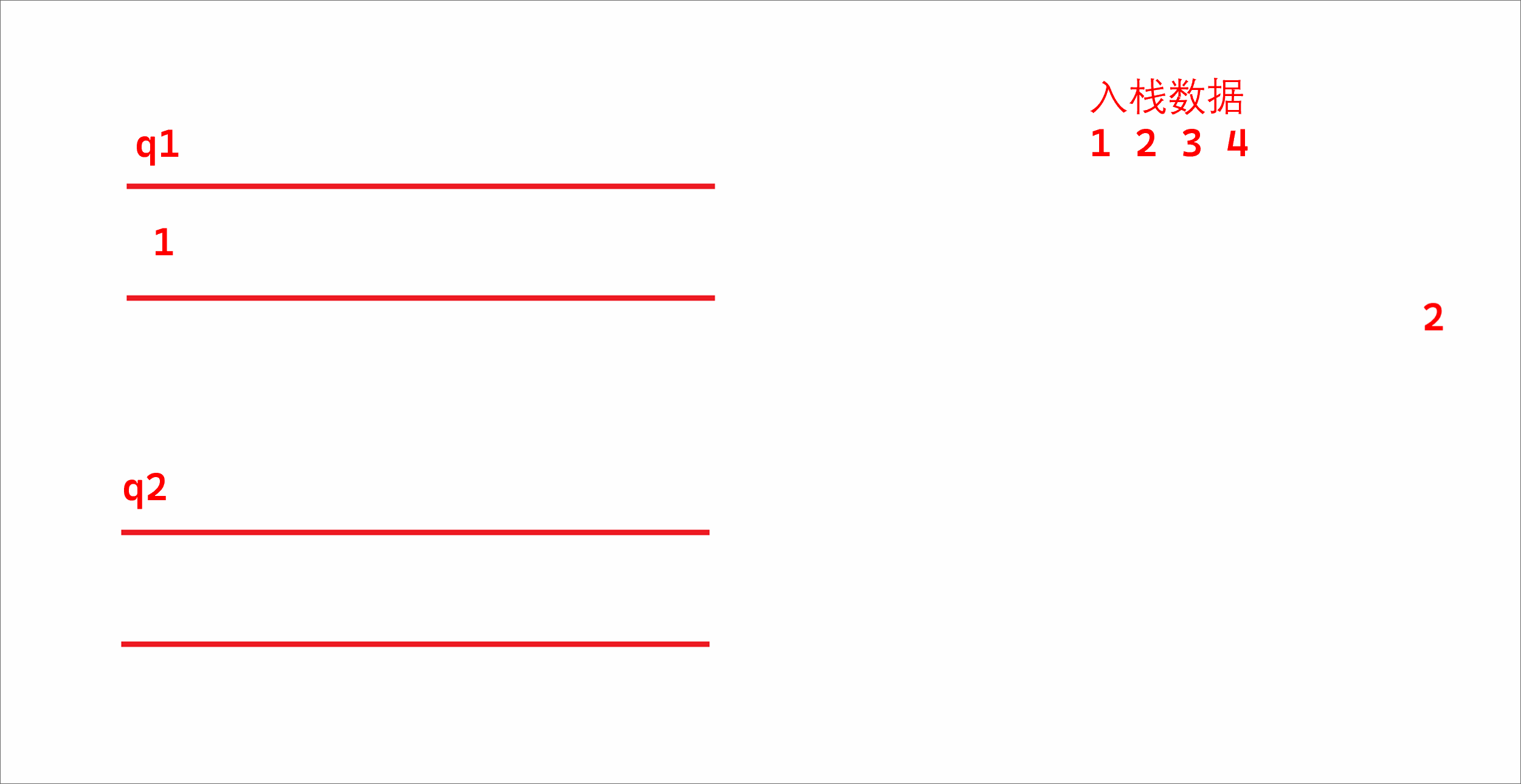. - 力扣(LeetCode)
题目描述

解题思路
这道题的思路就是使用两个队列来实现
入栈就是入队列
出栈就是将非空队列的前n-1个元素移动到新的队列中去
再将最后一个元素弹出
动画详解

代码实现
#define _CRT_SECURE_NO_WARNINGS 1#include <stdio.h>
#include <stdlib.h>
#include <stdbool.h>
#include <assert.h>typedef int QDataType;typedef struct QueueNode
{struct QueueNode* next;QDataType x;
}QNode;// 使用另一个结构体来存储头尾指针,指向队列的头尾
typedef struct Queue
{QNode* phead;QNode* ptail;int size;
}Queue;void QueueInit(Queue* pq)
{assert(pq);pq->phead = NULL;pq->ptail = NULL;pq->size = 0;
}void QueueDestroy(Queue* pq)
{assert(pq);QNode* cur = pq->phead;while (cur){QNode* next = cur->next;free(cur);cur = next;}pq->phead = pq->ptail = NULL;pq->size = 0;
}// 队尾插入
void QueuePush(Queue* pq, QDataType x)
{assert(pq);QNode* newnode = (QNode*)malloc(sizeof(QNode));if (newnode == NULL){perror("malloc fail");return;}newnode->next = NULL;newnode->x = x;if (pq->ptail == NULL){pq->phead = pq->ptail = newnode;}else{pq->ptail->next = newnode;pq->ptail = newnode;}pq->size++;
}// 队头删除
void QueuePop(Queue* pq)
{assert(pq);assert(pq->size != 0);/*QNode* next = pq->phead->next;free(pq->phead);pq->phead = next;if (pq->phead == NULL)pq->ptail = NULL;*/// 一个节点if (pq->phead->next == NULL){free(pq->phead);pq->phead = pq->ptail = NULL;}else // 多个节点{QNode* next = pq->phead->next;free(pq->phead);pq->phead = next;}pq->size--;
}QDataType QueueFront(Queue* pq)
{assert(pq);assert(pq->phead);return pq->phead->x;
}QDataType QueueBack(Queue* pq)
{assert(pq);assert(pq->ptail);return pq->ptail->x;
}int QueueSize(Queue* pq)
{assert(pq);return pq->size;
}bool QueueIsEmpty(Queue* pq)
{assert(pq);return pq->size == 0;
}typedef struct
{Queue q1;Queue q2;
} MyStack;MyStack* myStackCreate()
{// 使用malloc开辟新的栈,防止局部变量出作用域之后被销毁// 不能使用全局变量,因为下一次调用的时候全局变量不会初始化MyStack* obj = (MyStack*)malloc(sizeof(MyStack));// 调用队列初始化函数对两个队列进行初始化QueueInit(&(obj->q1));QueueInit(&(obj->q2));return obj;
}void myStackPush(MyStack* obj, int x)
{// 向不为空的队列插入数据if (QueueIsEmpty(&obj->q1)){QueuePush(&(obj->q1), x);}else{QueuePush(&(obj->q2), x);}
}int myStackPop(MyStack* obj)
{// 将前size-1个数据弹出,导入到不为空的队列中去,再删除非空队列中的最后一个数据// 使用假设法来判断空队列Queue* empty = &(obj->q1);Queue* notempty = &(obj->q2);if (!QueueIsEmpty(&(obj->q1))){notempty = &(obj->q1);empty = &(obj->q2);}// 开始遍历while (QueueSize(notempty) > 1){// 向空队列中插入非空队列中的数据QueuePush(empty, QueueFront(notempty));// 弹出非空队列的数据QueuePop(notempty);}int top = QueueFront(notempty);// 弹出非空队列中的最后一个数据,实现出栈操作QueuePop(notempty);return top;
}int myStackTop(MyStack* obj)
{if (!QueueIsEmpty(&obj->q1)){return QueueBack(&obj->q1);}else{return QueueBack(&obj->q2);}
}bool myStackEmpty(MyStack* obj)
{return QueueIsEmpty(&(obj->q1)) && QueueIsEmpty(&(obj->q2));}void myStackFree(MyStack* obj)
{// 不能直接释放obj,因为还有剩下的链表没有释放,将成为野指针QueueDestroy(&obj->q1);QueueDestroy(&obj->q2);free(obj);
}/*** Your MyStack struct will be instantiated and called as such:* MyStack* obj = myStackCreate();* myStackPush(obj, x);* int param_2 = myStackPop(obj);* int param_3 = myStackTop(obj);* bool param_4 = myStackEmpty(obj);* myStackFree(obj);
*/复杂度分析
我们可以发现,这个代码仅有在将非空队列的元素导入空队列时有循环,因此时间复杂度为O(n)
总结
Bye!!





![[muduo网络库]——muduo库的Reactor模型(剖析muduo网络库核心部分、设计思想)](http://pic.xiahunao.cn/[muduo网络库]——muduo库的Reactor模型(剖析muduo网络库核心部分、设计思想))








)

(3)】初识神经网络之深度学习hello world)


